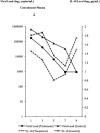Convalescent plasma treatment reduced mortality in patients with severe pandemic influenza A (H1N1) 2009 virus infection
- PMID: 21248066
- PMCID: PMC7531589
- DOI: 10.1093/cid/ciq106
Convalescent plasma treatment reduced mortality in patients with severe pandemic influenza A (H1N1) 2009 virus infection
Abstract
Background: Experience from treating patients with Spanish influenza and influenza A(H5N1) suggested that convalescent plasma therapy might be beneficial. However, its efficacy in patients with severe pandemic influenza A(H1N1) 2009 virus (H1N1 2009) infection remained unknown.
Methods: During the period from 1 September 2009 through 30 June 2010, we conducted a prospective cohort study by recruiting patients aged ≥ 18 years with severe H1N1 2009 infection requiring intensive care. Patients were offered treatment with convalescent plasma with a neutralizing antibody titer of ≥ 1:160, harvested by apheresis from patients recovering from H1N1 2009 infection. Clinical outcome was compared with that of patients who declined plasma treatment as the untreated controls.
Results: Ninety-three patients with severe H1N1 2009 infection requiring intensive care were recruited. Twenty patients (21.5%) received plasma treatment. The treatment and control groups were matched by age, sex, and disease severity scores. Mortality in the treatment group was significantly lower than in the nontreatment group (20.0% vs 54.8%; P = .01). Multivariate analysis showed that plasma treatment reduced mortality (odds ratio [OR], .20; 95% confidence interval [CI], .06-.69; P = .011), whereas complication of acute renal failure was independently associated with death (OR, 3.79; 95% CI, 1.15-12.4; P = .028). Subgroup analysis of 44 patients with serial respiratory tract viral load and cytokine level demonstrated that plasma treatment was associated with significantly lower day 3, 5, and 7 viral load, compared with the control group (P < .05). The corresponding temporal levels of interleukin 6, interleukin 10, and tumor necrosis factor α (P < .05) were also lower in the treatment group.
Conclusions: Treatment of severe H1N1 2009 infection with convalescent plasma reduced respiratory tract viral load, serum cytokine response, and mortality.
Figures
References
-
- Chang YS, van Hal SJ, Spencer PM, et al. Comparison of adult patients hospitalised with pandemic (H1N1) 2009 influenza and seasonal influenza during the “PROTECT” phase of the pandemic response. Med J Aust. 2010;192:90–3. - PubMed
-
- Echevarria-Zuno S, Mejia-Arangure JM, Mar-Obeso AJ, et al. Infection and death from influenza A H1N1 virus in Mexico: a retrospective analysis. Lancet. 2009;374:2072–9. - PubMed
-
- Louie JK, Acosta M, Winter K, et al. Factors associated with death or hospitalization due to pandemic 2009 influenza A(H1N1) infection in California. JAMA. 2009;302:1896–902. - PubMed
Publication types
MeSH terms
Substances
LinkOut - more resources
Full Text Sources
Other Literature Sources
Medical




